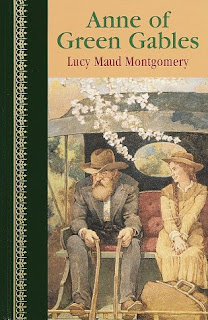
 Montgomery, L.M. 1908. Anne of Green Gables.
Montgomery, L.M. 1908. Anne of Green Gables.
I first 'discovered' Anne Shirley through watching the 1985 and 1987 films by Kevin Sullivan/Wonderworks when they aired on my local PBS station. As far as I'm concerned, these two are the ONLY films that are 'real.' Meaning that the monstrosity of a film released in 2000 doesn't exist at all. It's something that should be avoided at all costs. It is evil, evil, pure evil.
It would have been around sixth or seventh grade (1989-1990 or 1990-1991) that I 'discovered' the Anne of the books by L.M. Montgomery. It was love at first sight pure and simple. I loved Anne of Green Gables, yes, but I loved all of the Anne books. Then I moved from loving all the Anne books to loving all the Emily books. And then I started loving all the stand-alone novels too...like Tangled Web and Blue Castle. And then I discovered the short story collections. My sister started it, I suppose. She was the official owner of all the L.M. Montgomery books. And she never let me forget it either. I simply loved and adored L.M. Montgomery. She was the best of the best as far as I was concerned.
What is there to love about Anne Shirley? Everything! She's creative, imaginative, bright, vibrant, contagiously fun, good-spirited, and lovable. In a word she is charming. Oh to see the world through the eyes of Anne. There is something so wonderfully innocent and optimistic about Anne.
In Anne of Green Gables (1908), the reader is introduced to Avonlea. We meet Anne, Marilla, Matthew, Rachel, Diana, Gilbert, and those awful Pyes as well. The characters, the settings, the rich-and-detailed text...everything about this book is perfect.
Anne of Green Gables
Walk with her through Avonlea
Kindred spirit, yes?
© Becky Laney of Becky's Book Reviews
Viewing: Blog Posts Tagged with: by the decades challenge, Most Recent at Top [Help]
Results 1 - 9 of 9
Blog: Becky's Book Reviews (Login to Add to MyJacketFlap)
JacketFlap tags: "A" Titles, classic, YA Historical Fiction, J Historical Fiction, J Fiction, Heart of a Child Challenge, by the decades challenge, "M" Authors, Add a tag
Blog: Becky's Book Reviews (Login to Add to MyJacketFlap)
JacketFlap tags: J Fantasy, by the decades challenge, Inklings Challenge, initials reading challenge, "T" Authors, "H" Titles, Add a tag
 Tolkien, J.R.R. 1937, 1966. The Hobbit.
Tolkien, J.R.R. 1937, 1966. The Hobbit.
In a hole in the ground there lived a hobbit. Not a nasty, dirty, wet hole, filled with the ends of worms and an oozy smell, nor yet a dry, bare, sandy hole with nothing in it to sit down on or to eat: it was a hobbit-hole, and that means comfort. (3)
Hobbits do like to be comfortable. That is a fact. But in The Hobbit, we read of one hobbit in particular, a Mr. Bilbo Baggins, who leaves his life of comfort behind him to go on a once-in-a-lifetime adventure with thirteen dwarves and one wizard. It is the story of how he went from being a respectable hobbit to a very unrespectable, "odd" little hobbit. Bilbo never meant to have an adventure. He was quite clear on that. But never say never. It all starts with a visit from a wizard, Gandalf. That visit leads to another visit--a visit by thirteen dwarves--who call upon him unawares and give him the surprise of his life. They want him--they expect him--to be a part of their expedition, their adventure, their journey to go off and kill a dragon, Smaug by name, and steal his treasure. It's laughable almost, at least at first, but slowly and surely Bilbo gets carried away with it all. And the adventures that follow--oh my!
The Hobbit is a charming and delightful though-not-a-thin adventure book that everyone should read. (Or at least attempt to read! By that I mean, while I loved it--while I think many many people love it--I suppose no one book can please everyone. But this one should at least be attempted, tested to see if you like this sort of thing.)
© Becky Laney of Becky's Book Reviews
Blog: Becky's Book Reviews (Login to Add to MyJacketFlap)
JacketFlap tags: brothers and/or sisters, J Fiction, 888 Challenge, by the decades challenge, themed reading challenge 2008, Add a tag


Cleary, Beverly. 1975. Ramona the Brave.
Yesterday, I reviewed Ramona the Pest. I love that book. I love the illustrations. The classic illustrations. The illustrations I grew up with. The edition of Ramona the Brave that I was able to find on the library shelves was ghastly. Maybe ghastly is too strong a word. Okay, I admit it is exaggerating it a bit. 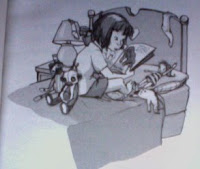 I suppose it's what I can expect from HarperCollins. The publishers that removed the Garth Williams illustrations from the Little House books wouldn't bat an eye about updating the illustrations for Ramona. These new illustrations are by Tracy Dockray. And they are wrong, wrong, wrong. Mostly wrong in principle, but wrong all the same. Just a note, a rather important note: the covers that I've been pairing with the reviews are the new books with the new illustrations.
I suppose it's what I can expect from HarperCollins. The publishers that removed the Garth Williams illustrations from the Little House books wouldn't bat an eye about updating the illustrations for Ramona. These new illustrations are by Tracy Dockray. And they are wrong, wrong, wrong. Mostly wrong in principle, but wrong all the same. Just a note, a rather important note: the covers that I've been pairing with the reviews are the new books with the new illustrations.
Ramona the Brave. The book in hand. "Ramona Quimby, brave and fearless, was half running, half skipping to keep up with her big sister Beatrice on their way home from the park." Ramona is getting ready to start the first grade now. Big changes are on the way, Beezus now wants to be called Beatrice. Mrs. Quimby is going to be working outside the home. (Shocking, I know. But this was the seventies.) And the Quimbys' are going to be adding another room onto the house so that Beezus and Ramona won't have to share. All that in addition to both girls starting a new school year.
A new school year, a new teacher, some old familiar classmates. Ramona wants to be a good girl. And she's going to try her best not to let Susan and her boing-boing curls tempt her into trouble. But Susan is not making it easy. Susan's prone to copy-catting and tattle taling.
First grade is not making a good impression on Ramona. And her teacher is not like Miss Binney at all. All Ramona wants is for her teacher to like her, to appreciate her, to understand her, to not label her a trouble-maker.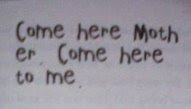 Drama, drama, drama. I enjoyed Ramona the Brave. Certainly some parts are memorable. Her destroying Susan's owl and then later repenting and feeling guilty. Her note to her mother gets me every time. Such real emotion. And the bit about her getting chased with a dog and making a new shoe with some paper and a stapler. Her loving Beezus' teacher? Gotta love that!
Drama, drama, drama. I enjoyed Ramona the Brave. Certainly some parts are memorable. Her destroying Susan's owl and then later repenting and feeling guilty. Her note to her mother gets me every time. Such real emotion. And the bit about her getting chased with a dog and making a new shoe with some paper and a stapler. Her loving Beezus' teacher? Gotta love that!
But the absolutely best scene in Ramona the Brave. The one that makes it all worth while. Is Chapter Eight: Ramona Says A Bad Word. The bad word in question. Well, I'll just have to let you see:
Ramona had had enough. She had been miserable the whole first grade, and she no longer cared what happened. She wanted to do something bad. She wanted to do something terrible that would shock her whole family, something that would make them sit up and take notice. "I'm going to say a bad word!" she shouted with a stamp of her foot. That silenced her family. Picky-picky stopped washing and left the room. Mr. Quimby looked surprised and--how could he be so disloyal--a little amused. This made Ramona even angrier. Beezus looked interested and curious. After a moment Mrs. Quimby said quietly, "Go ahead, Ramona, and say the bad word if it will make you feel any better." Ramona clenched her fists and took a deep breath. "Guts!" she yelled. "Guts! Guts! Guts!" There. That would show them. Unfortunately, Ramona's family was not shocked and horrified as Ramona had expected. (137-138)
Don't you just love it? I especially love the process of how it's resolved. "Her parents continued to sit in silence, but Ramona was past caring what anyone did. She cried harder than she ever had cried in her life. She cried until she was limp and exhausted. Then Ramona felt her mother's hand on her back.d 'Ramona,' she said gently, 'what are we going to do with you?' With red eyes, a swollen face, and a streaming nose, Ramona sat up and glared at her mother. 'Love me!' Her voice was fierce with hurt. Shocked at her own words, she buried her face in the pillow. She had no tears left." (141)
Such raw emotion that is as authentic as can be. No wonder I connected with Ramona growing up!
Blog: Becky's Book Reviews (Login to Add to MyJacketFlap)
JacketFlap tags: J Fiction, 888 Challenge, Heart of a Child Challenge, by the decades challenge, themed reading challenge 2008, Add a tag
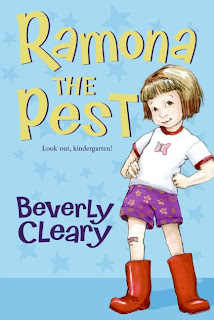
 Cleary, Beverly. 1968. Ramona the Pest.
Cleary, Beverly. 1968. Ramona the Pest.
"I am not a pest," Ramona Quimby told her big sister Beezus.
Ramona is back. Originally published in 1968, a full decade after Beezus and Ramona, Ramona the Pest follows Ramona as she enters a strange, new world: kindergarten. Now five years old, Ramona is ready--or so she thinks--to conquer this thing called school. Eager to learn to read and write so she can catch up with her older sister Beezus. But what Ramona doesn't expect to be quite so challenging is the ever-going struggle to be good, to stay good through the course of a school day. Staying in her seat. Being quiet. Following the rules. Playing nicely with others. Ramona hasn't encountered much resistance. This has been Ramona's philosophy, and up to a point, it has always worked for her: "If she had to, she would make a great big noisy fuss, and when Ramona made a great big noisy fuss, she usually got her own way. Great big noisy fusses were often necessary when a girl was the youngest member of the family and the youngest person on her block." (12) So you can only imagine what a rude awakening is in store for her as she enters Miss Binney's kindergarten class.
Ramona the Pest is completely delightful. The novel is from Ramona's perspective, and she captures kid-thinking, kid-acting so authentically. Ramona and her classmates. What can I say? There's the ever-so-cute, ever-so-kissable Davy, Susan with the boing-boing curls, and Howie who is Ramona's playmate not by choice but because their parents are good friends. What I didn't realize growing up was how authentically she captures the teacher, Miss Binney.
I have so many favorite scenes from Ramona the Pest. But my favorite favorite favorite scene comes from chapter five, "Ramona's Engagement Ring." Henry Huggins, boy hero, saves Ramona and earns her new-found love and attention.
One of the things that makes these novels so charming, so perfectly delightful (besides the brilliantly witty and authentic characters and dialogue) is the artwork by Louis Darling.
Blog: Becky's Book Reviews (Login to Add to MyJacketFlap)
JacketFlap tags: brothers and/or sisters, J Fiction, 888 Challenge, Heart of a Child Challenge, by the decades challenge, themed reading challenge 2008, Add a tag
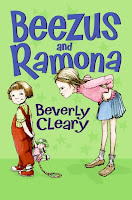
 Cleary, Beverly. 1955. Beezus and Ramona.
Cleary, Beverly. 1955. Beezus and Ramona.
Originally published in 1955, Beezus and Ramona is a true children's classic. Beezus, age 9, and Ramona, age 4, are the stars of Beezus and Ramona. This story is told from Beezus' perspective. (I believe the others in the series are told from Ramona's perspective.) This is how it opens: "Beatrice Quimby's biggest problem was her little sister Ramona. Beatrice, or Beezus (as everyone called her, because that was what Ramona had called her when she first learned to talk), knew other nine-year-old girls who had little sisters who went to nursery school, but she did not know anyone with a little sister like Ramona." If you've read any of the Ramona series, you know what she's talking about. Ramona. That love-to-hate, pesky little sister who is always into something. She has to be one of the best-loved, most-memorable characters ever created.
In Beezus and Ramona, we see the family dynamics of the Quimby household and the tension between two sisters. Beezus is almost perpetually frustrated with her younger sister. And Ramona is well, Ramona. Prone to wanting what she wants when she wants it.
I must have read this series dozens and dozens of times growing up. But I haven't read it recently. I probably last read it in 1999. Ramona is just as great as I remembered it. Each chapter has a scene that I almost know by heart. From the opening chapter, where Ramona's fascination with steam shovels lead her to destroy a library book, to the last chapter where Ramona's imaginative "acting-out" of Hansel and Gretel leads her to bake her doll, Bendix, in the oven and ruin her sister's birthday cake in the process.
I highly recommend this series to readers young and old. I think they make especially nice read-alouds! You can read the first chapter online here.
Blog: Becky's Book Reviews (Login to Add to MyJacketFlap)
JacketFlap tags: YA Fantasy, YA Romance, by the decades challenge, Once Upon A Time Challenge II, TBR Challenge, Mythopoeic Award Challenge, Add a tag

 Gaiman, Neil. 1999. Stardust.
Gaiman, Neil. 1999. Stardust.
If this book doesn't have you at hello, I don't know that I can help you. There was once a young man who wished to gain his Heart's Desire. And while that is, as beginnings go, not entirely novel (for every tale about every young man there ever was or will be could start in a similar manner) there was much about this young man and what happened to him that was unusual, although even he never knew the whole of it. What a great beginning. It's just so beautiful, so magical. Doesn't it just feel right?
Stardust is set in nineteenth century England in the community of Wall. (1830s and 1840s to be exact.) This community is built by a large (and by large I mean high and long) grey rock wall. There is a gap in the wall, however, a gap that is guarded at all times. Guarded so no one--especially children--can slip through, and guarded so no one can slip in. Beyond the gap, there is a meadow, a beautiful meadow that is forbidden. Forbidden except for one day (and one night) every nine years when the Faerie market comes to the meadow. This is the only time when the two communities (the rather mundane humans and the fantastical, magical faerie world) interact. Our novel opens with us meeting Dunstan Thorn.
I really can't say much more about it. I could, but I won't. It's magical. It's beautiful. It's adventuresome. It's just great storytelling. I loved every moment of it. There were so many things I loved about it that I couldn't begin to describe them in such a way as to do the book and its characters justice. Just trust me. If you haven't met Neil Gaiman, use Stardust as an introduction!!! This isn't my first Gaiman. It's my third. But it is by far my favorite.
Blog: Becky's Book Reviews (Login to Add to MyJacketFlap)
JacketFlap tags: 888 Challenge, In Their Shoes Challenge, Back to History Challenge, Spring Reading Challenge, Nonfiction Five, by the decades challenge, Banned Books Challenge, Reading Full Circle Challenge, Jewish Literature Challenge, Add a tag
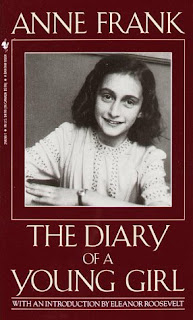
Frank, Anne. 1952. The Diary of A Young Girl.
"You're reading that again?" That's what my mother said as she caught me reading Anne Frank. Like I haven't read anything but this one book in all these years. She's right. I have read Anne Frank's Diary of A Young Girl before. But some things are worth repeating. Diary of A Young Girl is one of them. The first time I read this book, I would have been in high school. Close enough to Anne's age to feel it--the drama of adolescence on top of extreme political and social upheaval. The Diary of A Young Girl captures both. The war. The threat of death. The threat of captivity. The threat of starvation and disease. But it also captures youth. What it means to be young, to be at that ever-awkward stage in life, in development. Always a me-in-the-making, never quite done finding out who you are and what you believe and what you want out of life. Anne could be any girl in any place and time. But because she was born a Jew. Because Hitler came to power. Her life--her perfectly ordinary life--was cut short.
The book begins in June of 1942. The last entry is in August of 1944. In these two years, these two turbulent years, Anne and her family and several other people as well all go into hiding in the Secret Annexe. Mr. and Mrs. Frank. Margot, the older sister. Mr. and Mrs. Van Daan. Their son Peter. And Mr. Dussel. Eight people. Cramped living conditions. This isn't reality tv. This is life and death. Yes, every person gets super-cranky and super-sensitive. But wouldn't you?
The reader gets a glimpse into the lives of real people through the eyes of one very young sometimes-mature, sometimes-immature girl. Anne Frank. Very famous now because of her diary. But just then--at the moment--one very ordinary girl with a natural desire to write a diary. I think most kids (or teens) at one time or another try their hand at keeping journals. Though perhaps now, blogging has replaced all that. Diaries are intimate, personal, private. Each entry is a snapshot into that one day, that one hour, that one moment. When you're young, (and even when you're older and supposedly all grown up) your mood, your outlook changes moment by moment, day by day. Happy one minute, miserable the next. Such is the case with Anne. Personally, I'm surprised that Anne had as many happy moments, contented moments, grateful moment in the Annexe as she did. I think it would only be natural to be unhappy, scared, miserable, depressed. Living in cramped quarters with people you dislike, people you disagree with, not being able to go outside, to go anywhere you want. Not having the freedom to move, to make noise when you want. To always be on alert. To always worry about the threat of discovery, the threat of capture, the threat of bombs blowing you to bits. High stress. Very high stress.
But this isn't just a book about war, about being Jewish, about being a victim. This book is so much more than that. It's a book about growing up. A book about changing from a girl into a young woman with hopes and dreams and fears and desires. It's a book about being that age. That extremely awkward stage of life. My mom thought all people of that age should be shipped off to junior high island until they grew out of it. That moody, I-hate-you, you-don't-understand-me stage. Anne was a work-in-progress. There's no doubt about it. When we first meet her, she's entering that phase of life. She doesn't get along with her mother. At all. She feels completely disconnected from her. Misunderstood. Unloved. Unwanted. Unappreciated. And her relationship with her father is better, but not perfect. Sometimes she feels the disconnect with him too. And her sister. She feels that her parents love her sister more. That her sister gets all the praise, the love, the positive attention. And she feels that she gets attacked, bombarded with negative attention--lectures, lectures, more lectures. Everyone is always out-to-get-her. But though this does seem to be Anne's story, Anne's predicament, by the second half of the book, Anne is growing, changing, maturing. She looks back over past entries and realizes that things are different, things have changed. And she realizes that most of the changes were in her. She is beginning to build, to establish a better relationship with her family. She is beginning to get comfortable in her own skin.
Anne is someone I think we all can relate to in a way. Anne was just a girl. A girl with interests and hobbies. Likes and dislikes. She could be anybody.
The Diary of A Young Girl was originally published in Holland in 1947. It was soon translated into other languages, including English, and printed in the United States. 1952 is the first publication date for the United States. Almost from the very beginning, it was recognized as a good book, a powerful book, a book worthy of time and attention and respect. But it's not without its enemies.
Though I'll never in a million years understand the mindset of those that challenge books, I'll never ever ever understand why Diary of A Young Girl is one of their targets. I just don't understand it. Can't understand it. One challenge brought against the book stated that it was pornographic. How??? Why??? Fortunately, the challenge failed, and the book stayed on the shelves. I suppose pornography is subjective. But a young girl writing about her period is so not pornographic! A young girl writing about her breasts developing? Not pornographic. A young girl writing about her first kiss? Not pornographic. There is no talk, no hint of sex in the book. Though Anne spends the last part of the book making out with Peter, the son of the Van Daans. But it's not pornographic in the slightest. Not unless it's the mention of Anne reading a book where there is mention of a woman selling her body. Or perhaps it is the conversation about the cat's male organs that is so offensive to folks? Whether the cat is a tom cat.
I could go on for hours about all the suffering the war has brought, but then I would only make myself more dejected. There is nothing we can do but wait as calmly as we can till the misery comes to an end. Jews and Christians wait, the whole earth waits, and there are many who wait for death. (64)
I see the eight of us with our "Secret Annexe" as if we were a little piece of blue heaven, surrounded by heavy black rain clouds. The round, clearly defined spot where we stand is still safe, but the clouds gather more closely about us and the circle which separates us from the approaching danger closes more and more tightly. (115)
But seriously, it would seem quite funny ten years after the war if we Jews were to tell how we lived and what we ate and talked about here. Although I tell you [the diary] a lot, still even so, you only know very little of our lives. (192)
And if I haven't any talent for writing books or newspaper articles, well, then I can always write for myself. . . I want to go on living after my death! And therefore I am grateful to God for giving me this gift, this possibility of developing myself and of writing, of expressing all that is in me. I can shake off everything if I write; my sorrows disappear, my courage is reborn. But, and that is the great question, will I ever be able to write anything great, will I ever become a journalist or a writer? I hope so, oh, I hope so very much. (197)
Blog: Becky's Book Reviews (Login to Add to MyJacketFlap)
JacketFlap tags: J Fantasy, series challenge, by the decades challenge, Inklings Challenge, Once Upon A Time Challenge II, Add a tag
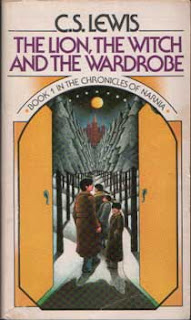
 The Lion, The Witch, and The Wardrobe
The Lion, The Witch, and The Wardrobe![]() by C.S. Lewis
by C.S. Lewis
My review of C.S. Lewis' classic children's book The Lion, The Witch, and the Wardrobe is going to be chatty--quite chatty--and there's nothing I can do about it. I first encountered the magic of Narnia in fourth grade when my teacher read it aloud to us. My teacher, Mrs. Watts, was known for many things. She inspired much fear and trembling. Like Aslan, she was not tame, but good. While, other students may remember the discipline or the hard work...I'll always remember my magical introduction to Narnia. Soon after, I added book by book the series to my collection. Most of my copies were used. Most were ugly. But I devoured each one. I seem to remember my sister reading a few of the series at least. But unlike Little House and Ramona and Anne, this series was more me and less her. Narnia belonged to me--the magic, the wonder, the glory of it all. I remember the pure pleasure I experienced each and every time I opened up a book. I remember the book covers, yes. And I definitely have strong opinions on which book covers through the years are 'the best' of the bunch. But more precisely, I fell in love with the proper order of the series. Few things irritate me more than someone who insists on that new-fangled order. Which is why, if you could see me, you'd know how frustrating it is to read my 7-in-1 novel. But some things must be preserved at all costs.
But unlike Little House and Ramona and Anne, this series was more me and less her. Narnia belonged to me--the magic, the wonder, the glory of it all. I remember the pure pleasure I experienced each and every time I opened up a book. I remember the book covers, yes. And I definitely have strong opinions on which book covers through the years are 'the best' of the bunch. But more precisely, I fell in love with the proper order of the series. Few things irritate me more than someone who insists on that new-fangled order. Which is why, if you could see me, you'd know how frustrating it is to read my 7-in-1 novel. But some things must be preserved at all costs.
Once there were four children whose names were Peter, Susan, Edmund, and Lucy. This story is about something that happened to them when they were sent away from London during the war because of the air-raids. (p. 111 in the 7-in-1 edition)
The adventures in and out of the wardrobe that these four experience during the course of the novel are oh-so-magical. The characters--both major and minor--so memorable. The story, familiar yet resilient, even after having read it a dozen times. So many wonderful scenes. Scenes that resonate. In case you haven't read it, let me give you a teaser. Lucy, the youngest of the children, accidentally discovers a magical land of ice and snow while hiding in a wardrobe in the Professor's house. Her three siblings--Peter, Susan, and Edmund--at first don't believe her. They take her tale as a wild, silly, foolish story of a girl whose homesick and wanting attention. Edmund, the brother closest to her in age and thus her biggest tormentor, also wanders into Narnia unexpectedly. But who he meets there, will perhaps undo them all. Narnia is not a land at peace. Not at all. For the land is under a spell--an enchantment--the White Witch--the supposed Queen of the land--has made it always winter and never Christmas. And the lives of the children--all four children--are in grave danger when they're in Narnia. For there is a prophecy that four humans--two sons of Adam and two daughters of Eve--will come to rule the land as Kings and Queens and restore peace and order to the kingdom.
The heart and soul of The Lion, The Witch, and The Wardrobe is the revelation of Aslan, the King of the land, a lion.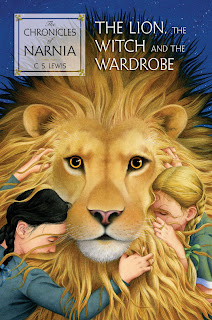 And now a very curious thing happened. None of the children knew who Aslan was any more than you do; but the moment the Beaver had spoken these words everyone felt quite different. Perhaps it has sometimes happened to you in a dream that someone says something which you don't understand but in the dream it feels as if it has some enormous meaning--either a terrifying one which turns the whole dream into a nightmare or else a lovely meaning too lovely to put into words, which makes the dream so beautiful that you remember it all your life and are always wishing you could get into that dream again. It was like that now. At the name of Aslan each one of the children felt something jump in its inside. Edmund felt a sensation of mysterious horror. Peter felt suddenly brave and adventurous. Susan felt as if some delicious smell or some delightful strain of music had just floated by her. And Lucy got the feeling you have when you wake up in the morning and realize that it is the beginning of the holidays or the beginning of summer. (141 of 7-in-1 edition)
And now a very curious thing happened. None of the children knew who Aslan was any more than you do; but the moment the Beaver had spoken these words everyone felt quite different. Perhaps it has sometimes happened to you in a dream that someone says something which you don't understand but in the dream it feels as if it has some enormous meaning--either a terrifying one which turns the whole dream into a nightmare or else a lovely meaning too lovely to put into words, which makes the dream so beautiful that you remember it all your life and are always wishing you could get into that dream again. It was like that now. At the name of Aslan each one of the children felt something jump in its inside. Edmund felt a sensation of mysterious horror. Peter felt suddenly brave and adventurous. Susan felt as if some delicious smell or some delightful strain of music had just floated by her. And Lucy got the feeling you have when you wake up in the morning and realize that it is the beginning of the holidays or the beginning of summer. (141 of 7-in-1 edition)
The children's journey to Narnia, their quest to meet Aslan at the Stone Table, and their battle to save Narnia and their brother from the grasp of the evil and wicked witch....are unforgettable adventures that deserve to be experienced again and again by readers of all ages. You're never too old to experience the magic of Narnia.
Here's the super-trailer for the movie:
Blog: Becky's Book Reviews (Login to Add to MyJacketFlap)
JacketFlap tags: classic, Spring Reading Challenge, romance reading challenge, by the decades challenge, Jane Austen mini-challenge, Nineteenth Century Women Writers' Challenge, Add a tag
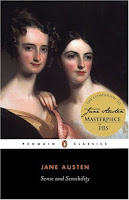

Sense and Sensibility by Jane Austen. What can I say? I didn't love it like I loved (or loved, loved, loved) Persuasion or Pride and Prejudice. It was so different to Northanger Abbey in a way which makes it more difficult to compare. But in its favor, I didn't dislike it like I disliked Mansfeld Park or Emma. (A word on Emma's behalf. Emma, the character, annoys me. I know she's supposed to be annoying because she represents the young and foolish and rich and selfish and spoiled stereotype. But still. It's hard to like someone like that. It would be like reading a book told from Lydia's perspective. I wonder if anyone has done that???)
Sense and Sensibility is the story of the Dashwood family. The mother has recently been widowed. She's got a step-son who's inherited everything, and her own three daughters. She's also got a daughter-in-law from hell. Really. This woman would make even a saint think that. The two are somewhat indirectly pushed out the door by the couple--Mr. and Mrs. John Dashwood. They're insufferable to live with. And they're rude and pushy. Contemptible really. The only good thing that happens is that Elinor meets a young man, Edward Ferrars, and falls in love. Though nothing is promised or exchanged between them.
The Dashwoods (mother and three daughters: Elinor, Marianne, Margaret) move to a cottage quite a distance away. (Barton I believe is the place where they're staying.) While there, Marianne 'makes' two men fall in love with her. Colonel Brandon, a respectable but older gentleman, and the young and dashing and ever-so-handsome Mr. Willoughby. Marianne sees only Willoughby. Brandon doesn't stand a chance. They also meet many people in the neighborhood--Mrs. Jennings, the Middletons, the Palmers, the Steeles, etc.
The story centers around the love lives of the two older sisters Elinor and Marianne. Often the two are down on their luck. Money plays a big role in the novel. But Jane Austen loved happy endings so never fear. It may take a good many pages, but Marianne and Elinor are assured of finding men that suit them perfectly one way or another.
368 pages.
Originally published in 1811.
First sentence: The family of Dashwood had long been settled in Sussex.







Yes, yes, yes!! I agree with you about the fab Megan Follows/Colleen Dewhurst version, but I was originally introduced to Anne by a fine BBC production in the 1970s. Sadly, it's not available anymore, and it's not as good as the PBS one.
I love that Anne is so wonderfully spacy and imperfect, and has such a nose for mischief and trouble. And, of course, her imagination is just lovely. She was definitely my role model and, yes, I did feel like a kindred spirit. For one thing, I drove the Marillas in my life nuts (Mrs. D. in my book was definitely inspired by one of them, an old teacher of mine...)
I loved the movies! I can't remember if I read the books first or saw the movies first, but I loved them both. I don't know if I've read everything by L.M. Montgomery, but I must have read everything in my city library when I was younger. I can't recall it all now, but I remember being very fond of her writing.
I totally agree. I love everything I've read by Montgomery. There are still some out there I haven't read yet (a few Emilys and Janes and The Blue Castle, Among the Shadows,another Story Girl book etc.) It's wonderful that she not only wrote beautifully but was so productive.
I don't remember the movies - I saw a televised series - the one from the cover of one of the book editions - that I loved almost as much as the books!
If you haven't read Before Green Gables yet you should get hold of a copy - it's a very well written book and I'm enjoying finding out more about the young Anne
I read the Emily books first. Then all the Anne books. I didn't see the movies until I was an adult but thought Megan Follows and Emily Dewhurst were perfect. Oh, and Matthew--I loved Matthew in the movies.
Anne girl may be my all time favorite character.